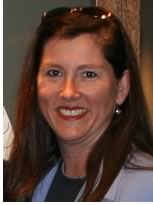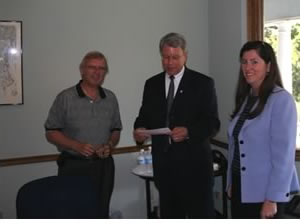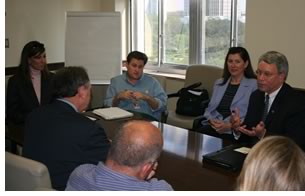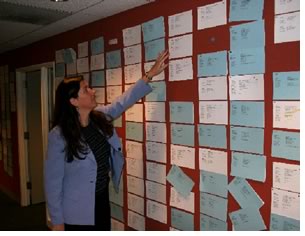

10/2005
 AIA New Orleans President
Angela O’Byrne, AIA, in a September 26 interview with AIArchitect at
AIA national headquarters, says she looks forward to the architecture
community’s role in the planning and rebuilding of her hometown
city. O’Byrne is the owner of Perez, APC, a 65-year-old New Orleans
firm.
AIA New Orleans President
Angela O’Byrne, AIA, in a September 26 interview with AIArchitect at
AIA national headquarters, says she looks forward to the architecture
community’s role in the planning and rebuilding of her hometown
city. O’Byrne is the owner of Perez, APC, a 65-year-old New Orleans
firm.
How are you and how are you coping logistically?
People have just been so kind. We are mourning the loss of parts of the
city and the diaspora. Everybody is just scattered to the four winds.
It took at least two weeks to locate family, friends, and coworkers.
I did finally locate everyone. No one’s phones were working,
so it was primarily through text messaging. Just staying in touch with
people has been really hard.
My house on the west side of New Orleans was damaged but did not flood. Most of my family’s homes didn’t flood and are less damaged than mine. I’m lucky that most of my staff live in Algiers. The office, on the 24th floor of a high-rise building is okay, but there are no utilities, power, water, or sewer. We have remobilized our office in the home of one the employees of the company. He has our e-mail and our server up, but it’s still rough. It’s tough getting equipment out from 24 floors up. My operations manager has done that, however, literally on his back.
 The operations manager finally rescued the computer that had our AIA
document software on it. That was tough because there’s all the
history, too. Imagine a project that’s nearing construction that
has 25 change orders in the hard drive of that one computer. We’re
working to service clients as if there was no interruption. Obviously
it’s a little hard on our end, but we’re trying to present
a continuous recovery front to clients.
The operations manager finally rescued the computer that had our AIA
document software on it. That was tough because there’s all the
history, too. Imagine a project that’s nearing construction that
has 25 change orders in the hard drive of that one computer. We’re
working to service clients as if there was no interruption. Obviously
it’s a little hard on our end, but we’re trying to present
a continuous recovery front to clients.
What do you hear from your fellow architects?
I’m hearing some offices did flood; everything is covered in 10
feet of water so there’s nothing that can be salvaged. I’ve
heard of other offices in high-rise buildings where all the glass blew
out. They thought they would be able to rescue the equipment, but it
is too damaged by wind and rain. I’m hearing from John Williams,
our past president, that his office is completely dry, and perfect like
nothing happened, and he’s on the first floor.
AIA New Orleans had its first meeting after the storm when [AIA Executive Vice President] Norman Koonce and [AIA President] Doug Steidl came. It was great emotionally for everyone to see each other and to see we were all okay. We really appreciate what AIA national is doing to locate people. Nobody’s cell phones are working, nobody knows where anybody is living, e-mail is not working, unless you have an Internet e-mail account. People don’t know everyone’s new address. Communication is the toughest thing.
How are architects handling their business affairs?
Architects are very much thinking about their clients. Some of them are
luckier than others because they had work outside of New Orleans. As
an example, my office has 25 active projects, two of them outside New
Orleans: one in north Louisiana, and one in Baton Rouge. So we actually
have a little bit of work. I did pick up a little bit of work in North
Louisiana after the storm. We’re all scrambling to try to keep
our companies together. Nobody is paying any bills and most of our
creditors have allowed us a 90-day deferment. I have been able to meet
payroll for my staff, but I won’t be able to do that indefinitely
without money coming in. I’m hoping with the work we have and
a little bit of work I picked up I can keep up until the end of year,
and hopefully by then there will be a lot more work.
How important is it for AIA New Orleans to establish a presence in the
city?
I think it’s critically important because of what architects do.
We are the designers and the planners. We’re what is needed right
now in New Orleans. We need to make sure we’re in the forefront
of working with the many, many, many groups who have expressed interest
in helping rebuild and plan the rebuilding. We’re hoping to take
that structure of the Sustainable Design Assessment Team (SDAT) and turn
it into a version of a R/UDAT to study the planning and building of the
city, short- and long-term.
 It’s extremely important for the AIA at every level to play a
prominent role. Our chapter in New Orleans isn’t big enough to
do it alone—we’re about 300 people. The entire state chapter
of Louisiana has 700 members. AIA Louisiana is helping us a lot, and,
of course, the national component is playing a critical role in helping.
It’s extremely important for the AIA at every level to play a
prominent role. Our chapter in New Orleans isn’t big enough to
do it alone—we’re about 300 people. The entire state chapter
of Louisiana has 700 members. AIA Louisiana is helping us a lot, and,
of course, the national component is playing a critical role in helping.
Our chapter had just done our very first annual strategic planning meeting,
literally a week before the storm. I really want to publish it in the
next 30 days, because a lot of the things we talked about doing are especially
needed now, for example, hiring full-time staff, opening a store front,
having a more visible presence, and being more accessible to and more
active in the community. The next president of AIA New Orleans, Steve
Braquet, AIA, is going to have his hands full. He and I are very much
aligned, as are our board members, on where we want to take AIA New Orleans.
What are the next steps for AIA New Orleans and for the city?
Re-engineering the city is the very first big step, which is more for
engineers than architects, but we certainly want to be at the table
being informed about what is going on, and that has to do with fixing
the levies and other Corps issues. Many articles have been written
about this, an especially good one was a 2001 Scientific
American article, “Drowning
New Orleans,” which actually talked about the issue of cities
located on river deltas. The problems are common to any river delta
city, including New York City and all the cities in the Netherlands.
Because the man-made development doesn’t allow the river to behave
in the way it normally would—rivers are supposed to flood their
deltas—it creates all sorts of unintended consequences.
Secondly, we need to start planning at a regional level things like transportation infrastructure and utilities, and then to be more focused. We need to start forming panels and having design charrettes, symposia, and discussions regarding housing, economic develop, health care, education, historic preservation—there are so many areas that need to be looked at. I think this storm, despite its devastation, is a wonderful opportunity to rebuild the city in a better way and make it a much better city than it was before.
How do you make sure development happens at an appropriate pace?
At the AIA, we’re trying hard to reach out to all the groups. We
want to hear what they have to say and we also do not want to duplicate
their efforts. We want to get everyone in the room together; it’s
going to be a very large room.
 We’re working on how to structure our efforts so they’re
inclusive and everyone is at the table. We want to make sure locals are
included. Also, like most chapters, we have a very small percentage of
minority participation, and yet the city is 70 percent African American,
so we have to include minority citizens’ voice in this planning
process.
We’re working on how to structure our efforts so they’re
inclusive and everyone is at the table. We want to make sure locals are
included. Also, like most chapters, we have a very small percentage of
minority participation, and yet the city is 70 percent African American,
so we have to include minority citizens’ voice in this planning
process.
What are you doing differently?
Generally speaking, New Orleans does not have a reputation for doing
things in a transparent way, so we want to take this opportunity to
start doing that. Already, the riverfront development charrettes that
we did two years ago have been highly effective. In May this year we
sponsored a smart growth summit. Everyone we invited, including our
U.S. Senator, Mary Landrieu, showed up from all corners of the city.
With the storm I don’t know if the results of that meeting will
ever be published because a lot was lost on computers. It depends on
whether the areas were flooded where the different teams were. We had
six design charrettes in three parishes and lots of participation from
local groups. As we publish these recommendations, as we did for the
riverfront, they are actually starting to be implemented. City officials
listen.
So, our efforts are attracting notice. At a recent meeting, one of our councilmen, Oliver Thomas, congratulated the architecture community for stepping up to the plate and playing a much more prominent public role in civic activities.
What message are you bringing to Capitol Hill when you speak with your
lawmakers this week?
The biggest message is to make sure a real comprehensive planning effort
happens before billions get spent too quickly and things are done badly.
Let’s take a deep breath, plan, and get some encouragement and
assistance from them in that regard. FEMA contractors are going to get
the billions and are going to run like crazy to spend that money. We’re
concerned about the spending happening without enough thought going into
it. Second, and more parochially, we’re all worried about cash
flow, so we’re hoping that they’ll encourage the FEMA contractors
to hire locally. Third, I have specific asks from more local groups and
interests as well as clients.
How can your colleagues best help?
The best way is to go to the disaster
relief section of the AIA national Web site so that it can be a
coordinated effort. Individual members of AIA New Orleans have posted
their requests. Everything you can think of will be needed, from family
needs to computers, office supplies, chairs, and tables as they try
to set up new offices.
Copyright 2005 The American Institute of Architects.
All rights reserved. Home Page ![]()
![]()
 |
||
How
can colleagues best help?
|
||